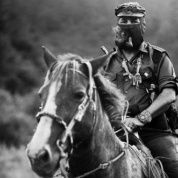January 1, 1994 is undoubtedly one of the most monumental dates in Mexico’s history.

It was the day that the North American Free Trade Agreement, NAFTA, came into effect. Establishing trilateral trade between Mexico, the United States and Canada. The agreement’s implementation greased the wheels for neoliberalism’s overrunning of the region’s poor.
It was also the day that the Zapatista Army of National Liberation, also referred to as the Zapatistas, declared war against the pro-NAFTA Mexican government. Guided by anti-neoliberal, anarcho-communist and Indigenous thought, the Zapatistas reignited the fight against global capitalism at a time when it was deemed to be “the best of all possible systems.”
Moreover, it was the day that the world came to know Rafael Sebastian Guillen Vicente, better known by his nom de guerre, Subcomandante Marcos. Donning a black ski mask, a tobacco pipe and a rifle, the Zapatista guerilla leader publically vowed to defeat NAFTA and neoliberalism alongside his Indigenous-led insurrectionary movement.
“We Zapatistas say that neoliberal globalization is a war of conquest of the entire world, a world war, a war being waged by capitalism for global domination,” Marcos and the Zapatistas said in their declaration.
“That is why we are joining together to build a resistance struggle against neoliberalism and for humanity.”
Marcos was born on June 19, 1957 in Tampico, Tamaulipas to a self-described middle-class family. His father, Alfonso, was a small business owner and grade school teacher who was able to finance his studies throughout his educational career.
After graduating from the private, Jesuit-run Tampico Cultural Institute, Marcos moved to Mexico City to study philosophy at the National Autonomous University of Mexico, UNAM. The public research university is considered to be the country’s most prestigious higher education institution.
While at UNAM, Marcos became heavily involved in Marxist student groups and study circles, solidifying his interests in defending workers and oppressed communities.
RELATED:
How Zapatistas Will Help Trump Victims with 'Fuck You' Coffee
Upon completing his studies, he began teaching philosophy at the Autonomous Metropolitan University, where he joined the Maoist National Liberation Forces, FLN, militant group.
Marcos’ transition from being an academic to an armed combatant began on October 2, 1968, when up to 400 students and civilians were assassinated by Mexican police and military in what is known as the Tlatelolco massacre. The slain students and civilians had held mass peaceful protests against the Mexican government over its harsh treatment of previous student protests against state repression and corruption.
In an attempt to suppress “communist agitators” ahead of the 1968 Summer Olympics in Mexico City, Mexican security officials assasinated the protesters. Today, the incident is regarded as a major pillar of Mexico’s Dirty War, a campaign of violence against leftist popular movements — a carbon copy of its South American counterpart.
The Tlatelolco massacre had a tremendous impact on Marcos, who became immersed in underground FLN activities aimed at overthrowing the Mexican state with “people’s war.”
In the early 1980s, Marcos abandoned his relatively comfortable life in Mexico City to promote armed struggle in the jungles of Central America. After unsuccessfully trying to recruit impoverished Indigenous Maya people in Chiapas to overthrow the Mexican state and ruling class, he reportedly moved to Nicaragua. There, he assisted the Marxist-Leninist Sandinista National Liberation Front, or Sandinistas, in their fight against the U.S.-backed, right-wing Contras under the nom de guerre “El Mejicano,” or “The Mexican.”
In the late 1980s, Marcos returned to Chiapas, reorganizing the FLN into the modern-day Zapatista Army of National Liberation Forces. He is said to have received training from the Sandinistas and the Salvadoran Farabundo Marti National Liberation Front, FMLN.
RELATED:
Zapatistas Back Indigenous Woman to Run for Mexico's Presidency
Incorporating Sandinista and FMLN guerilla warfare strategies, Marcos began preparing the Zapatistas for all-out war against the Mexican state in response to rising neoliberalism and renewed state repression.
The Zapatistas would eventually apply these strategies on the battlefield on January 1, 1994.
Marcos, joined by approximately 3,000 Zapatista guerillas, took command of dozens of cities and towns across Chiapas, burning down military bases and police stations along the way. The militants, however, were eventually overpowered by U.S.-backed Mexican armed forces that forced the rebels to retreat into the remote mountainous jungles of Chiapas.
Since then, the Mexican state has launched a number of counteroffensives against the Zapatistas, despite previous peace talks. Government officials have also tried to detain and imprison Marcos on charges of terrorism, sedition and possession of firearms, among others. However, attempts to convict Marcos came to a halt in February 2016, when a Mexican federal judge announced that the 1995 order for his arrest had expired.
Today, Marcos remains a key leader of the Zapatista movement, which recently elected a prominent Indigenous leader as their independent candidate for the upcoming 2018 presidential election in Mexico. Marcos and the Zapatistas remain critical of neoliberalism in Mexico and state-sanctioned violence against human rights activists.